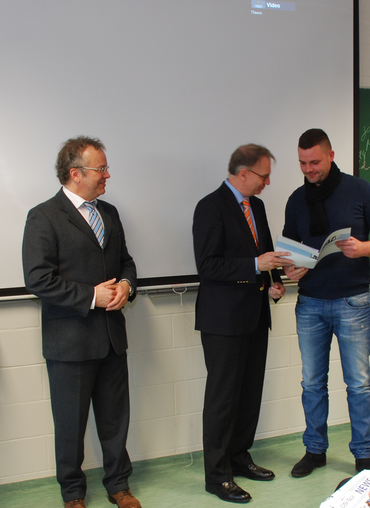Over 50 participants from eight countries (Estonia, Lithuania, Latvia, Russia, Ukraine, Belarus, Azerbaijan and Kazakhstan) took part in the event.
Not only welding technology but also, to an increasing extent, non-destructive testing are being included in the specialist work of the regional branch. For this purpose, the regional branch in the Baltic states maintains close international contacts to the countries in the region as well as to EWF - European Welding Federation and IIW - International Institute of Welding.
The annual assembly was supported by ESAB GmbH, Kemppi GmbH and EWM AG in the form of specialist contributions and practical appliance demonstrations and applications.
As in the past too, the conference venue was the Mehaanikakool in Tallinn / Estonia. Representatives of this college introduced the completely renovated and extended welding workshop in particular.
The General Manager of DVS, Mr. Roland Boecking, explained the objectives and tasks of DVS (particularly its commitment to training and further education as well as to technology and research) to the members of the regional branch in the Baltic states. Here, Boecking emphasised the commitment of DVS abroad. In this connection, Boecking welcomed the extensive work of the regional branch and promised the continued support of DVS.
Particular greetings were addressed to a few companies which were recently successful in having achieved the certification according to ISO 3834 (quality requirements on fabrication plants using welding technology) and according to EN 15085 (quality requirements on and certification of welding plants in rail vehicle construction), including the Stadler Rail Group, Daetwyler Industries and VERTEX.
An overview lecture delivered by Mr. Ulrich Dilthey, Past-President of IIW, featured a comprehensive description of the development of welding technology and joining technology - so to speak, as a success story. Dilthey compared joining technology with other production technologies and he introduced joining technology as a production technology of tomorrow and as a key technology for industrial production. On this subject, he gave a comprehensive explanation of applications in the vehicle industry, in energy and process technology, in the construction industry and in microsystems engineering. In this respect, he highlighted the fact that these industries would not be capable of functioning without joining technology - a statement which DVS also formulates in its image campaigns. Because of its significance, joining technology makes a contribution to the economic development in the various countries and safeguards value added and jobs while doing so.
Mr. Dieter Kocab from EWM AG transferred these thoughts (value added and jobs in Europe safeguarded by welding technology) in particular to modern welding processes, especially with regard to their application in steel and metal construction - particularly as far as applications of CrNi steels and aluminium alloys are concerned. Kocab emphasised the active supporting function for the welder / the user performed by modern appliance technology. On this subject, he introduced different arc forms and, in particular, explained the arcs with reduced energies and their possibilities for raising productivity in industrial practice. In this respect, he emphasised the necessity that changes in the designs of assemblies are frequently a prerequisite for economically viable fabrication and he proved this in the cases of bodywork assemblies and components of exhaust systems. In this respect, highly automated fabrication operations even on complex geometries lead to the integration of several work steps. Furthermore, Kocab introduced the processing of aluminium alloys by means of welding technology in the case of frame sections and machine assemblies.
For the umpteenth time, the subsequent discussion showed the necessity of incorporating findings and possibilities from the application of the new arc technology directly into the sets of rules and into the standardisation. However, such a development is frequently opposed by other opinions and interests. Therefore, these findings are incorporated into the sets of rules and the standards with a delay. These findings can be implemented more quickly in the training documents of GSI for the welding coordinators. For this purpose, GSI and EWM will make arrangements for advanced cooperation.
This was followed by specialist lectures which were delivered by representatives of GSI SLV Baltikum and VERTEX and discussed the applications of the European standards EN 1011 2 (recommendations for the welding of metallic materials) and EN 1090 2 (technical execution of steel and aluminium supporting structures).
The annual assembly of the DVS regional branch in the Baltic states ended with a report on the work in the past year (2014). The members from companies and educational establishments were offered comprehensive information about the technical development in welding technology. This included seminars and printed documents as well as the access to the technical bulletins, technical codes and guidelines of DVS. An extension to this available range of information with regard to training and further education, quality assurance and the auditing of companies is planned for 2015. The annual assembly ended with the formal approval of the actions of the board by the members.
Further information: hans-g.gross(at)gsi-baltikum.ee




